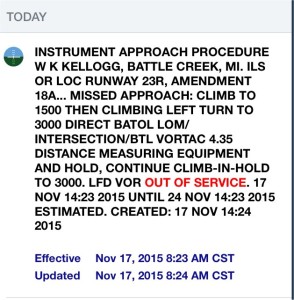Over the past month, I have on at least 3 occasions noted prior to flights that the approaches I would normally have intended to use for my destination airport were Out of Service when I checked NOTAMs. This was able to be managed when known ahead of time, but in two of the cases it did require some re-planning to make accommodations.
Know before you go, don’t forget to check those NOTAMs for your destination and alternate airports to make sure what you are planning on flying for approaches is going to be available and won’t leave you scrambling at the last minute to try to come up with a Plan B.
NOTAMs that affect approaches can be obtained through a weather briefing both digitally and on the phone, and in most modern flight planning applications on devices such as iPad’s they are easily retrievable.
 Be sure to check the details. It won’t always be the case that an approach is NOTAM’d completely out of service, but particular parts of it may be made unavailable, and depending on the type of equipment in your aircraft, it may or may not make the approach unusable by you for your flight.
Be sure to check the details. It won’t always be the case that an approach is NOTAM’d completely out of service, but particular parts of it may be made unavailable, and depending on the type of equipment in your aircraft, it may or may not make the approach unusable by you for your flight.
Many times, we find that VORs are out of service that define step-down fixes, NDBs that define outer markers may be out of service, or a glide-slope may be out of service. Each of these factors may not entirely make an approach unusable, but may change the minimums, may require that an aircraft with an IFR GPS use GPS data to supplement identification of a step-down or crossing fix, or may require use of an alternate missed approach procedure if the primary one is not able to be used.
This is much easier to think through and figure out if you are doing so prior to departure than it is if you are “in the soup” 10 miles from what you thought was going to be your final approach fix when you get the note from ATC that the approach is unavailable.
Work the details, know the systems in your aircraft and how each NOTAM affects if you can or cannot conduct an approach, and plan ahead for changes in runways.
Sometimes, approaches are not necessarily broken, but other factors may make them unusable. This may be temporary if, for example, they are doing some work or testing of the approach system (this recently was the case in Kalamazoo) or it may be a longer term issue if, and Battle Creek is a recent example, the runway is getting resurfaced making approaches come and go in availability over a month of time while the runway work was being conducted.
In a few cases, and one recently for me, the NOTAM closure of an approach was one that was for a certain period of time, with the approach going back in service after 5pm that day. The out of service notice was apparently for some planned maintenance on an ILS, so instead of planning to arrive around 4pm as we had originally intended, we shuffled our schedule to allow for an arrival after the approach was again active. While schedules can change and you should always be ready with a backup plan if an approach you plan to use doesn’t come back active if it had been down, you can sometimes work around planned outages by modifying your schedule.
Just because an approach was available yesterday, doesn’t guarantee that it will be available today or tomorrow for next flight.
It is easy for us to get a little lax in our checking of NOTAMs prior to every flight, especially at our home airports where we feel comfortable, in aircraft where we rely more heavily on GPS approach systems, and on routes we fly frequently. But things break, things change, and without knowing it ahead of time we can be left scrambling to catch up as pilots.
